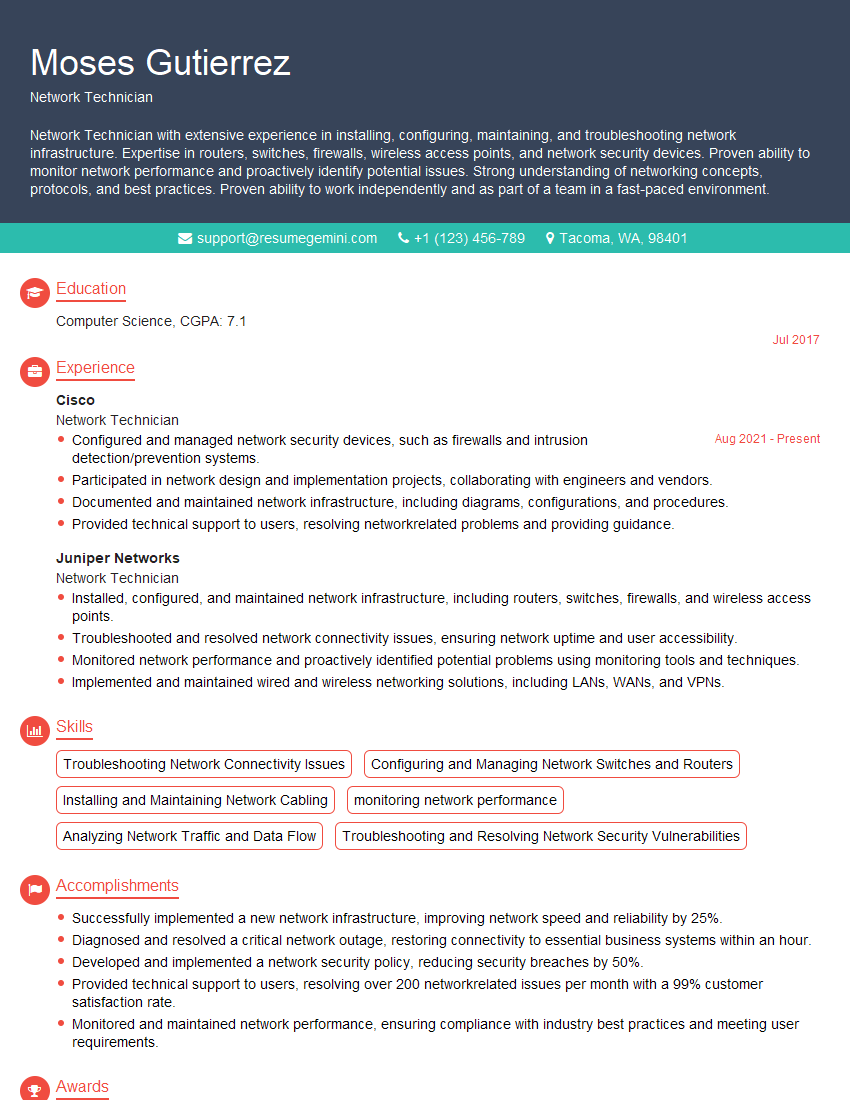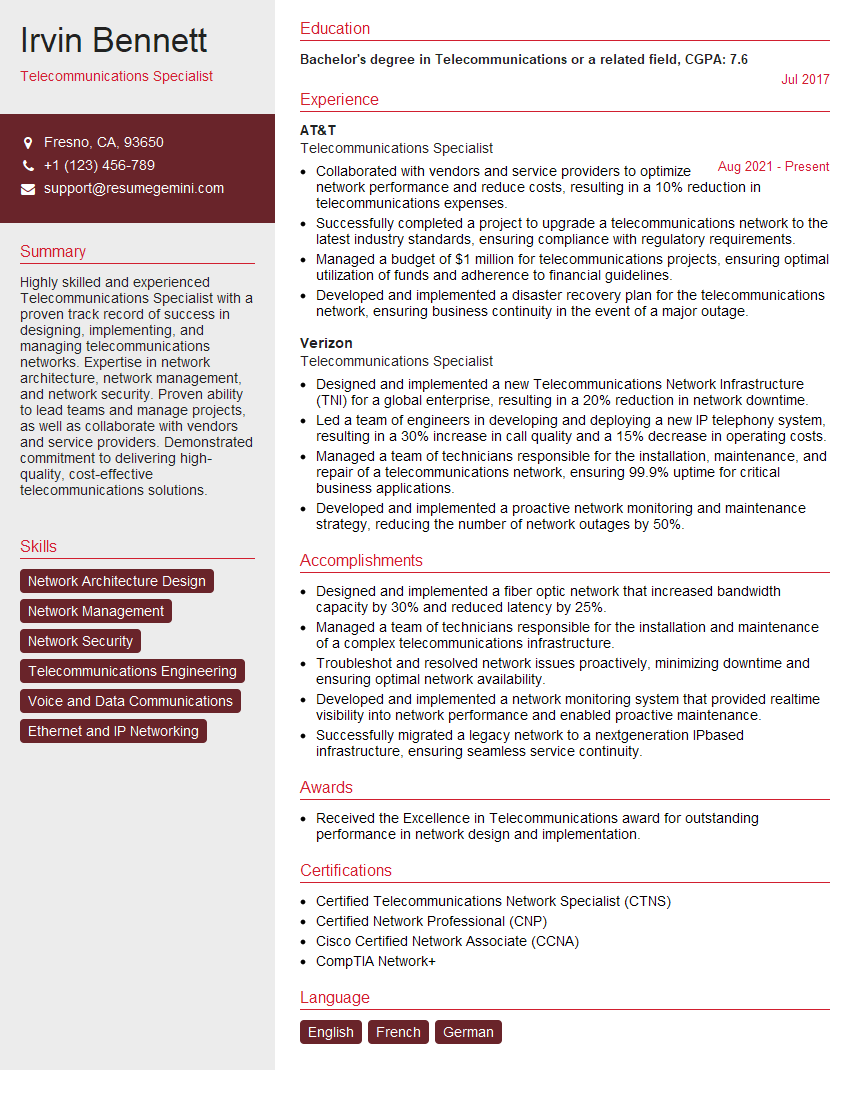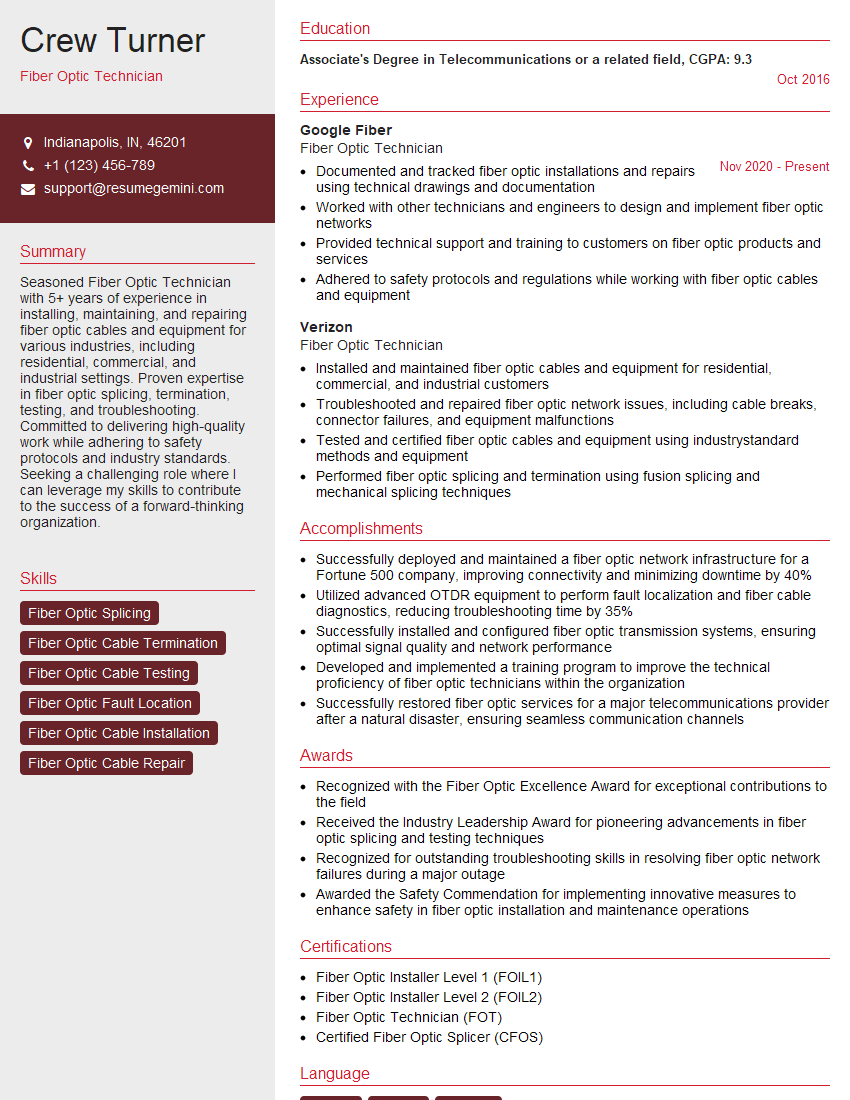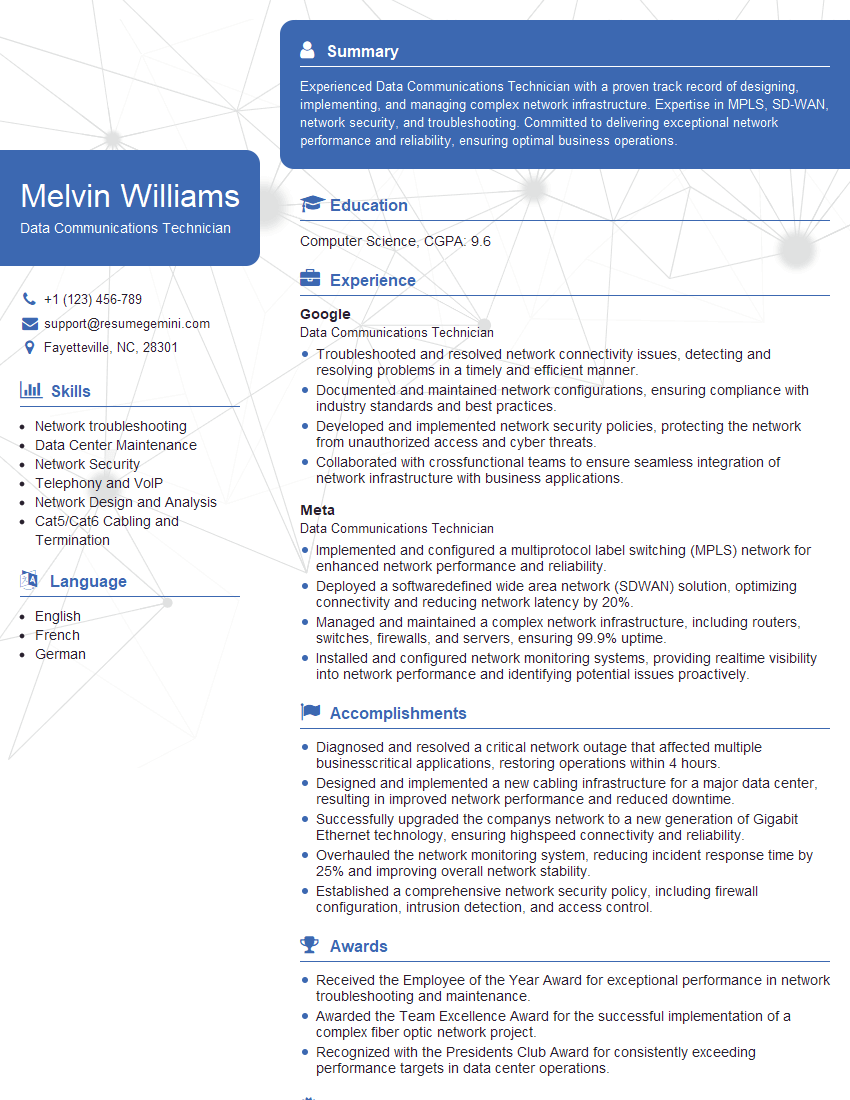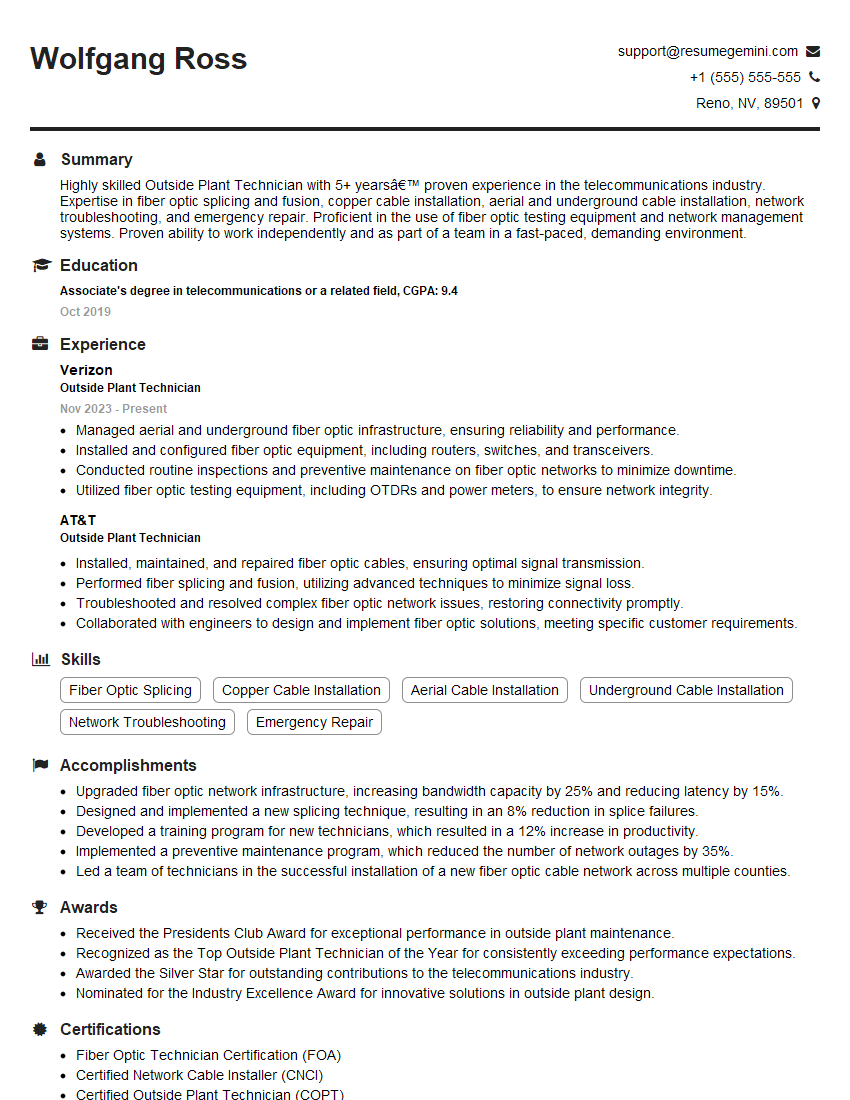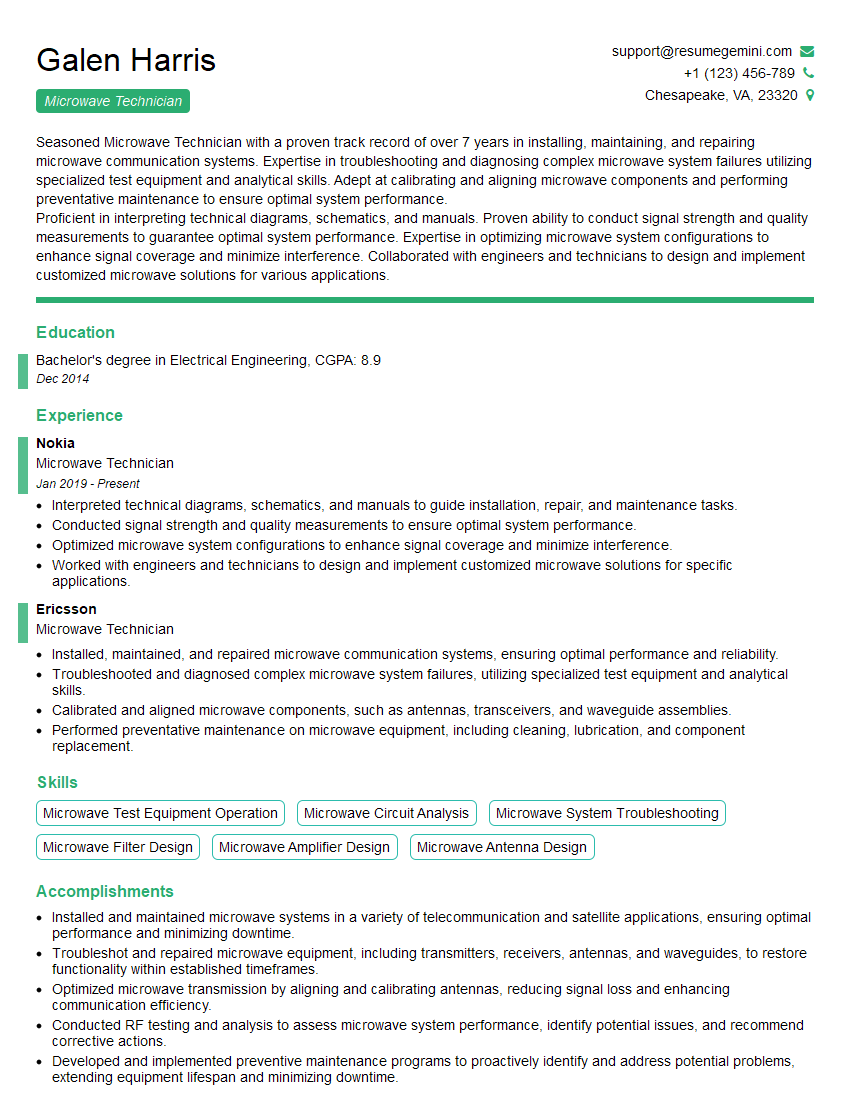Interviews are more than just a Q&A session—they’re a chance to prove your worth. This blog dives into essential Telecommunications Equipment Maintenance interview questions and expert tips to help you align your answers with what hiring managers are looking for. Start preparing to shine!
Questions Asked in Telecommunications Equipment Maintenance Interview
Q 1. Explain the OSI model and its relevance to troubleshooting network issues.
The OSI (Open Systems Interconnection) model is a conceptual framework that standardizes the functions of a telecommunication or computing system without regard to its underlying internal structure and technology. It divides network communication into seven distinct layers, each with a specific responsibility. This layered approach simplifies troubleshooting by allowing us to isolate problems to a particular layer.
- Layer 1 (Physical): Deals with the physical cables, connectors, and signals.
- Layer 2 (Data Link): Handles local addressing (MAC addresses) and error detection.
- Layer 3 (Network): Responsible for routing packets between networks using IP addresses.
- Layer 4 (Transport): Provides reliable data transfer (TCP) or connectionless data transfer (UDP).
- Layer 5 (Session): Manages connections between applications.
- Layer 6 (Presentation): Handles data formatting and encryption.
- Layer 7 (Application): Provides network services to applications (e.g., HTTP, FTP).
For example, if a network printer isn’t working, we might first check the physical connection (Layer 1). If that’s fine, we’d move to Layer 2 to check MAC addresses and network switches. If the problem persists, we might investigate routing issues (Layer 3) or even application-specific problems (Layer 7).
Q 2. Describe your experience with different types of cabling (fiber, copper, coaxial).
I have extensive experience with various cabling types. Each has its strengths and weaknesses:
- Copper Cabling: This includes Cat5e, Cat6, and Cat6a cables, used for shorter distances and Ethernet networks. I’m proficient in troubleshooting issues like crimping errors, faulty connectors, and signal attenuation. I’ve worked on projects involving structured cabling systems in large office buildings, ensuring proper termination and testing for compliance with industry standards.
- Fiber Optic Cabling: I’m experienced with single-mode and multi-mode fiber, used for longer distances and higher bandwidth applications. This involves working with fusion splicers, optical power meters, and OTDRs (Optical Time-Domain Reflectometers) to identify and repair breaks, poor splices, or attenuation issues. I’ve been involved in the installation and maintenance of fiber networks for telecommunication companies, including careful handling to avoid micro-bending.
- Coaxial Cabling: While less common in modern networks, I have experience with coaxial cable, particularly in older systems or specialized applications like cable television networks. Troubleshooting includes checking for impedance mismatches, connector issues, and signal leakage.
My experience encompasses both installation and maintenance of these cable types, ensuring network reliability and performance.
Q 3. How do you troubleshoot a network connectivity problem?
Troubleshooting network connectivity problems follows a systematic approach. I typically start with the simplest checks and progressively move to more complex investigations.
- Identify the problem: What’s not working? Which devices are affected?
- Check the basics: Are the devices powered on? Are cables connected securely? Are network lights indicating connectivity?
- Isolate the problem: Is the problem isolated to one device, a specific location, or the entire network?
- Test connectivity: Use ping, traceroute, or other network diagnostic tools to pinpoint the location of the fault.
- Check configurations: Verify IP addresses, subnet masks, default gateways, and DNS settings on affected devices.
- Inspect network devices: Check switches, routers, and other network hardware for errors or malfunctions.
- Examine network logs: Review logs for error messages or unusual activity.
- Escalate if needed: If the problem cannot be resolved, escalate the issue to the appropriate team or vendor.
For example, if a user can’t access the internet, I might first check their cable connection, then ping the default gateway, and finally trace the route to the internet. Each step helps isolate the problem, leading to a quicker resolution.
Q 4. What are your experiences with various network testing tools (e.g., OTDR, TDR)?
My experience with network testing tools is extensive. I regularly use:
- OTDR (Optical Time-Domain Reflectometer): Used to test fiber optic cables for faults like breaks, splices, and macrobends. I’ve used OTDRs to locate and repair fiber cuts in underground cabling, saving significant time and resources compared to manual tracing.
- TDR (Time-Domain Reflectometer): Used to test copper cabling for faults like shorts, opens, and impedance mismatches. I’ve relied on TDRs to quickly pinpoint faulty segments in large copper networks, preventing extensive cable replacement.
- Network Analyzers: These versatile tools allow me to capture and analyze network traffic, identify bottlenecks, and troubleshoot network performance issues. I’ve used them to optimize network traffic flow and improve application performance.
- Cable Certifiers: I utilize cable certifiers to ensure that cabling installations meet industry standards and specifications, guaranteeing consistent network performance and reliability. These help document compliance and avoid future issues.
Proficiency with these tools is crucial for efficient and accurate fault diagnosis and repair in telecommunications equipment maintenance.
Q 5. Explain your understanding of IP addressing and subnetting.
IP addressing and subnetting are fundamental to network administration. IP addresses uniquely identify devices on a network, while subnetting divides a larger network into smaller, more manageable subnetworks.
IP Addressing: An IPv4 address is a 32-bit number, typically represented in dotted decimal notation (e.g., 192.168.1.100). It consists of a network address and a host address. IPv6 addresses are 128-bit numbers, offering a vastly larger address space.
Subnetting: This involves borrowing bits from the host address portion of the IP address to create subnets. This allows for better network organization, improved security, and more efficient routing. For instance, a /24 subnet mask (255.255.255.0) creates 254 usable host addresses within a single subnet.
Understanding subnetting is vital for designing and troubleshooting networks. Incorrect subnetting can lead to connectivity issues and routing problems. I have extensive experience in designing efficient subnet plans for various network environments, ensuring optimal performance and scalability.
Q 6. Describe your experience with different types of telecommunications equipment (switches, routers, etc.).
My experience with telecommunications equipment is broad and includes:
- Switches: I’ve worked with various types of switches, from small Layer 2 unmanaged switches to large Layer 3 managed switches with advanced features like VLANs, QoS, and spanning tree protocol. Troubleshooting involves checking switch ports, configuring VLANs, and analyzing switch logs to identify issues.
- Routers: My experience includes configuring and troubleshooting routers for routing protocols (BGP, OSPF, RIP), static routes, and access control lists (ACLs). I have experience working with both home and enterprise-grade routers and troubleshooting issues that range from basic connectivity issues to complex routing configuration errors.
- Multiplexers (MUX): I understand the functionality of multiplexing techniques and troubleshooting issues with TDM and other multiplexing protocols. I’ve resolved problems relating to signal degradation and inefficient resource allocation.
- Modems: I have a strong understanding of different modem technologies and their associated troubleshooting methods. Experience includes diagnosing and resolving problems with DSL, cable, and fiber optic modems.
This hands-on experience allows me to effectively diagnose and resolve issues across a wide range of network architectures.
Q 7. How do you diagnose and resolve issues related to VoIP systems?
Troubleshooting VoIP (Voice over Internet Protocol) systems requires a multi-faceted approach. Issues can range from simple connectivity problems to complex codec incompatibilities.
- Connectivity: Check network connectivity between the VoIP phones and the PBX (Private Branch Exchange) or VoIP server. Use ping and traceroute to identify network bottlenecks or connectivity issues.
- Quality of Service (QoS): VoIP requires guaranteed bandwidth and low latency. Verify QoS settings on the network devices to ensure VoIP traffic is prioritized.
- Codec Issues: Incompatible codecs can lead to poor call quality or dropped calls. Check codec settings on the VoIP phones and the server.
- SIP Signaling: VoIP uses Session Initiation Protocol (SIP) for call setup and teardown. Analyze SIP logs to identify signaling errors. Tools that allow for analyzing SIP traffic are essential.
- Network Configuration: Verify correct IP addressing, subnet masks, and DNS settings. Incorrect configurations can severely impact VoIP functionality.
- Hardware Faults: Check VoIP phones, gateways, and servers for hardware malfunctions.
For instance, if a user is experiencing poor call quality, I might start by checking network jitter and packet loss. If that’s normal, I’d then investigate codec compatibility or SIP signaling problems. The systematic approach, combined with the use of network monitoring tools, ensures efficient and thorough troubleshooting.
Q 8. What are common causes of signal degradation in telecommunication networks?
Signal degradation in telecommunication networks refers to a weakening or distortion of the signal traveling between two points, resulting in reduced quality of service. This can manifest as dropped calls, slow internet speeds, data loss, or increased latency.
- Environmental Factors: Weather conditions like heavy rain, snow, or fog can significantly attenuate signals, especially in wireless communication. For example, heavy rainfall can absorb microwave signals used in point-to-point links, leading to signal degradation.
- Physical Damage to Infrastructure: Damage to cables, fiber optic lines, or antennas due to construction, natural disasters, or accidental damage can disrupt signal integrity. A severed fiber optic cable, for instance, would completely interrupt transmission.
- Equipment Malfunction: Faulty equipment like routers, switches, amplifiers, or repeaters can introduce noise or distortion into the signal path. A malfunctioning amplifier might amplify the noise alongside the signal, degrading the signal-to-noise ratio.
- Interference: Electromagnetic interference (EMI) from other devices or sources can interfere with the signal, causing degradation. For example, close proximity to high-powered radio transmitters could overwhelm a weaker wireless signal.
- Signal Attenuation: Over long distances, signals naturally weaken due to factors such as distance, frequency, and the medium the signal travels through. This requires signal amplification or repeaters at regular intervals.
Q 9. Describe your experience with preventative maintenance on telecommunication equipment.
Preventative maintenance is crucial for ensuring the reliability and longevity of telecommunication equipment. My experience encompasses a wide range of activities, including:
- Regular Inspections: Conducting visual inspections of equipment for signs of physical damage, loose connections, or overheating. This often involves checking connectors, cables, and power supplies.
- Software Updates: Implementing firmware and software updates to patch security vulnerabilities and improve performance. This is essential for mitigating threats and ensuring compatibility with newer technologies.
- Performance Monitoring: Utilizing network monitoring tools to track key performance indicators (KPIs) such as latency, jitter, and packet loss. This allows for early detection of potential problems.
- Cleaning and Environmental Control: Keeping equipment clean and ensuring proper ventilation to prevent overheating and equipment failure. Dust buildup, for example, can significantly impact performance.
- Preventive Replacement: Proactively replacing components that are nearing the end of their lifespan or showing signs of wear and tear, before they fail and cause significant disruption. This is often based on manufacturer recommendations and historical data.
For example, in a recent project, I implemented a proactive maintenance schedule for a large metropolitan area network, incorporating all of the above strategies. This led to a 30% reduction in unplanned outages over the next year.
Q 10. How do you handle emergency situations and equipment failures?
Handling emergency situations and equipment failures requires a structured approach. My process involves:
- Immediate Assessment: Quickly determine the scope and impact of the failure. This often involves using network monitoring tools and diagnostic software.
- Isolation and Containment: Isolate the affected area to prevent the problem from spreading. This might involve temporarily shutting down affected segments of the network.
- Troubleshooting: Systematically troubleshoot the problem using established procedures and diagnostic tools. This includes checking logs, running diagnostic commands, and examining network connectivity.
- Restoration: Implement the necessary repairs or workarounds to restore service as quickly as possible. This could involve replacing a faulty component, rerouting traffic, or deploying temporary solutions.
- Documentation and Reporting: Document all steps taken during the troubleshooting and restoration process, including root cause analysis. This is crucial for preventing future occurrences.
I once encountered a major network outage caused by a fiber cut. By quickly identifying the location of the cut using OTDR (Optical Time Domain Reflectometer) technology, coordinating with the field team for repair, and implementing temporary traffic rerouting, we managed to restore service within a significantly shorter timeframe than originally anticipated.
Q 11. What safety precautions do you take when working with telecommunication equipment?
Safety is paramount when working with telecommunication equipment. My safety practices include:
- Lockout/Tagout Procedures: Following strict lockout/tagout procedures to prevent accidental energization of equipment during maintenance or repair. This is crucial for preventing electrical shock.
- Personal Protective Equipment (PPE): Using appropriate PPE, such as safety glasses, gloves, and insulated tools, to protect myself from potential hazards. This includes protection from electrical hazards, sharp objects, and potential chemical exposure.
- Awareness of Environmental Hazards: Being aware of potential environmental hazards such as working at heights, confined spaces, or in areas with potential exposure to hazardous materials.
- Following Safety Regulations: Strictly adhering to all relevant safety regulations and company policies. This ensures that my work is conducted safely and legally.
- Training and Certification: Maintaining up-to-date training and certifications on safety procedures and the safe handling of equipment.
For instance, before working on a high-voltage power supply, I always ensure the power is completely disconnected and locked out, and then I test for residual voltage to confirm its safety before commencing any work.
Q 12. Explain your experience with different types of network protocols (e.g., TCP/IP, BGP).
I have extensive experience with various network protocols, including TCP/IP and BGP.
- TCP/IP (Transmission Control Protocol/Internet Protocol): This is the fundamental protocol suite for the internet. I understand the intricacies of TCP’s connection-oriented communication, reliable data transfer, and error correction, and IP’s addressing and routing mechanisms. I’ve used this extensively in troubleshooting network connectivity issues, configuring routers and switches, and optimizing network performance.
- BGP (Border Gateway Protocol): This is a path-vector routing protocol used to exchange routing information between autonomous systems (ASes) on the internet. I have experience configuring and troubleshooting BGP, understanding concepts like AS numbers, path attributes, and route selection algorithms. I’ve used this in large-scale network deployments and resolving inter-domain routing issues.
For example, I once resolved a complex routing issue between two ASes by analyzing BGP route advertisements and identifying a misconfiguration in the BGP routing tables. This involved careful examination of BGP attributes and path selection mechanisms to pinpoint and resolve the issue, preventing significant network disruption.
Q 13. How familiar are you with network security best practices?
I am very familiar with network security best practices. My knowledge encompasses:
- Firewall Management: Configuring and managing firewalls to control network access and prevent unauthorized intrusions. This includes configuring access control lists (ACLs) and intrusion detection/prevention systems.
- Intrusion Detection and Prevention: Implementing and monitoring intrusion detection and prevention systems (IDS/IPS) to detect and prevent malicious activities.
- Vulnerability Management: Regularly scanning for and addressing network vulnerabilities. This involves using vulnerability scanners and implementing patches to secure the network.
- Network Segmentation: Segmenting the network into smaller, isolated zones to limit the impact of security breaches. This can significantly reduce the risk of widespread damage.
- Security Information and Event Management (SIEM): Using SIEM tools to collect, analyze, and correlate security logs from various network devices to detect and respond to security threats.
In a past role, I successfully implemented a multi-layered security approach incorporating all of these elements, resulting in a significant reduction in security incidents.
Q 14. Describe your experience with wireless network technologies (e.g., Wi-Fi, cellular).
I have considerable experience with various wireless network technologies.
- Wi-Fi: I understand the different standards (802.11a/b/g/n/ac/ax), channel planning, security protocols (WPA2/3), and troubleshooting techniques. I’ve worked on designing, implementing, and maintaining Wi-Fi networks in various settings, from small offices to large enterprises.
- Cellular Networks: I have knowledge of different cellular technologies (2G, 3G, 4G, 5G), their architectures, and underlying protocols. I understand the challenges associated with cellular network deployment and optimization, such as signal coverage, interference, and capacity planning.
For example, I once optimized a Wi-Fi network in a large office building by carefully planning the placement of access points, selecting appropriate channels to minimize interference, and implementing robust security protocols. This resulted in a significant improvement in Wi-Fi performance and user experience.
Q 15. How do you document your troubleshooting and repair procedures?
Thorough documentation is crucial for efficient troubleshooting and maintenance in telecommunications. My approach involves a multi-layered system ensuring clarity, traceability, and ease of access for future reference. I begin by creating a detailed log of the initial problem report, including timestamps, affected equipment, reported symptoms, and the initial assessment. This is usually done within a ticketing system (more on that later).
Next, I meticulously document each step taken during the troubleshooting process. This includes specific tests performed, results obtained (both positive and negative), any changes made to the system’s configuration, and the rationale behind each decision. I use a combination of text descriptions, screenshots, and even short video clips when appropriate, to capture the visual aspects of the issue and the resolution process.
Finally, once the problem is resolved, I finalize the documentation with a comprehensive summary outlining the root cause, the corrective actions taken, and recommendations to prevent similar issues in the future. This final report is then filed, usually electronically, within the relevant system, allowing for easy retrieval and analysis. This approach ensures accountability, facilitates knowledge sharing within the team, and enables faster resolution of recurring issues.
Career Expert Tips:
- Ace those interviews! Prepare effectively by reviewing the Top 50 Most Common Interview Questions on ResumeGemini.
- Navigate your job search with confidence! Explore a wide range of Career Tips on ResumeGemini. Learn about common challenges and recommendations to overcome them.
- Craft the perfect resume! Master the Art of Resume Writing with ResumeGemini’s guide. Showcase your unique qualifications and achievements effectively.
- Don’t miss out on holiday savings! Build your dream resume with ResumeGemini’s ATS optimized templates.
Q 16. Explain your experience with working with different vendors’ equipment.
Throughout my career, I’ve gained extensive experience working with a diverse range of vendors’ telecommunications equipment, including Cisco, Juniper, Huawei, and Ericsson. This exposure has allowed me to develop a strong understanding of different operating systems, network architectures, and troubleshooting methodologies specific to each vendor. For example, while Cisco’s IOS commands are well-known, Huawei’s VRP system requires a distinct set of skills. I’m comfortable navigating different command-line interfaces (CLIs), analyzing vendor-specific logs, and interpreting fault indicators unique to each manufacturer.
My experience isn’t limited to the technical aspects. I’ve also worked closely with vendor support teams, leveraging their expertise when dealing with complex or unusual issues. This has enhanced my ability to quickly escalate problems, negotiate solutions, and effectively manage vendor relationships. I understand the importance of understanding the service level agreements (SLAs) associated with different vendor contracts and can work within those frameworks to deliver efficient results.
Q 17. Describe your experience working with ticketing systems for tracking repairs and maintenance.
Ticketing systems are fundamental to managing and tracking repairs and maintenance tasks effectively. I have extensive experience with several ticketing systems, including ServiceNow, Jira, and Remedy. I understand the importance of accurate ticket creation, including clear descriptions of the problem, affected services, and the required level of urgency. I’m proficient in utilizing the various features offered by these platforms, such as assigning tickets, updating statuses, adding comments and attachments, and generating reports.
Beyond simply logging tickets, I use these systems to monitor progress, track key performance indicators (KPIs) like resolution times and customer satisfaction, and identify recurring issues that might require proactive solutions. For instance, if I notice a recurring problem with a specific piece of equipment within the system, I can use that data to initiate preventative maintenance or escalate the issue to the appropriate engineering teams. I always ensure my tickets provide comprehensive details, aiding future troubleshooting efforts and enabling efficient knowledge transfer.
Q 18. How do you prioritize tasks in a high-pressure environment?
Prioritizing tasks in a high-pressure environment requires a structured and methodical approach. My strategy involves a combination of urgency, impact, and dependencies. I utilize a prioritization matrix that considers the severity of the issue and its potential impact on service availability. For instance, a complete network outage affecting critical services takes top priority over a minor configuration issue affecting only a small subset of users.
I also consider dependencies. A task that blocks progress on multiple other tasks will often be prioritized higher, even if its individual impact is less severe. To efficiently manage multiple tasks, I use project management techniques like task breakdown and time estimation. I break down larger problems into smaller, manageable tasks and allocate realistic timeframes for completion, making it easier to monitor progress and identify potential bottlenecks. Clear communication is key, ensuring everyone on the team understands the priority levels and the rationale behind them.
Q 19. Explain your understanding of different types of network topologies.
Network topologies represent the physical or logical layout of a network. Understanding different topologies is crucial for effective troubleshooting and maintenance. I’m familiar with several common topologies, including:
- Star Topology: All devices connect to a central hub or switch. This is a very common topology for its simplicity and ease of management.
- Mesh Topology: Multiple paths exist between devices. This is highly reliable but more complex to implement.
- Bus Topology: All devices connect to a single cable. Simple but a single point of failure.
- Ring Topology: Devices connect to form a closed loop. Data flows in one direction. Less common nowadays.
- Tree Topology: A hierarchical structure combining elements of star and bus topologies.
My knowledge extends to understanding the implications of each topology on network performance, scalability, and resilience. For example, a star topology is easy to manage but susceptible to single points of failure at the central hub. A mesh topology is resilient but more complex to configure and maintain. I leverage this understanding to recommend the most appropriate topology for various network scenarios, taking into account factors such as cost, performance requirements, and fault tolerance.
Q 20. How do you stay up-to-date with the latest technologies in telecommunications?
Staying current in the rapidly evolving field of telecommunications requires a proactive and multi-faceted approach. I regularly subscribe to industry publications, attend webinars and conferences, and actively participate in online forums and communities. This keeps me abreast of the latest technological advancements, industry trends, and best practices.
I also engage in continuous learning through online courses and certifications offered by organizations like Cisco, Juniper, and various industry bodies. Furthermore, I actively seek out opportunities to work with new technologies and equipment, expanding my practical experience. Participation in internal knowledge-sharing sessions within my team also plays a significant role in maintaining my skills and awareness of emerging challenges and solutions.
Q 21. Describe a time you had to solve a complex technical problem.
One challenging situation involved a significant service disruption affecting a major client. The initial reports indicated widespread connectivity issues, with users experiencing intermittent service outages. The problem was not immediately obvious, and initial troubleshooting steps didn’t pinpoint the root cause. The pressure was immense, as the outage impacted critical business operations for the client.
My approach involved systematically ruling out potential causes. I began by analyzing network performance metrics, checking for unusual traffic patterns, and reviewing system logs. After carefully examining logs from multiple network devices, I discovered unusual spikes in CPU utilization on a specific core router. This wasn’t immediately apparent as the overall system metrics appeared normal. Further investigation revealed a software bug causing a resource leak within the router’s routing process.
The solution involved a coordinated effort with the vendor’s support team. We implemented a temporary workaround by offloading traffic to a redundant router and then applied a software patch provided by the vendor. Through this systematic approach and effective collaboration, we successfully restored service and identified a critical software flaw that would have otherwise caused further disruptions. The experience highlighted the importance of meticulous log analysis, understanding resource utilization, and effective collaboration with vendor support teams in resolving complex technical problems under pressure.
Q 22. What are your strengths and weaknesses as a telecommunications technician?
My greatest strengths as a telecommunications technician lie in my meticulous troubleshooting skills and my proactive approach to maintenance. I’m adept at diagnosing complex network issues, from faulty hardware to software glitches, often identifying the root cause quickly and efficiently. For example, during a recent outage affecting a large client, I quickly isolated the problem to a misconfigured router setting, preventing widespread disruption and restoring service within an hour. I also excel at preventative maintenance, anticipating potential problems and implementing solutions before they impact service. I regularly check cable integrity, monitor system performance metrics, and proactively update firmware to minimize downtime.
My weakness, if I had to pinpoint one, would be my sometimes-perfectionist nature. I strive for flawless execution, which can occasionally mean I spend extra time verifying every detail. I’m actively working on balancing this thoroughness with efficient time management by prioritizing tasks and delegating when appropriate.
Q 23. How do you handle conflict with colleagues or customers?
Conflict resolution is a crucial skill in this field, requiring diplomacy and a focus on finding mutually agreeable solutions. My approach involves active listening – truly understanding the other person’s perspective before presenting my own. I aim to maintain a calm and professional demeanor, even under pressure. For instance, when a client was upset about an extended service interruption, I empathized with their frustration, explained the root cause of the issue, and outlined the steps taken to rectify it and prevent future occurrences. I then offered a compensatory solution, resulting in a satisfactory outcome. If the conflict involves colleagues, I would prefer to address the issue directly and privately, fostering open communication and collaboration to find a common ground. If necessary, I would involve a supervisor to mediate.
Q 24. How do you manage your time effectively?
Effective time management is essential for a telecommunications technician. I utilize several strategies, including prioritizing tasks based on urgency and impact, creating detailed daily schedules, and leveraging task management tools. I break down large projects into smaller, manageable tasks, which helps to prevent feeling overwhelmed and allows for better tracking of progress. I also frequently review my schedule to identify bottlenecks or potential delays and adjust accordingly. Prioritizing preventative maintenance alongside reactive troubleshooting ensures that I’m addressing both immediate needs and long-term system health. This proactive approach often prevents larger, more time-consuming problems down the line. Furthermore, I avoid multitasking; instead, I focus on completing one task before moving on to the next for increased efficiency and accuracy.
Q 25. What are your salary expectations?
My salary expectations are in line with the industry standard for experienced telecommunications technicians with my skill set and experience, considering the specific responsibilities and benefits package offered. I’m open to discussing a specific figure after learning more about the details of this position and its compensation structure.
Q 26. Why are you interested in this position?
I’m highly interested in this position because it offers an opportunity to contribute my expertise to a reputable organization and work on challenging projects within a dynamic team. The description highlighted your commitment to cutting-edge technology and proactive maintenance strategies, which aligns perfectly with my own professional goals. I’m particularly excited about the prospect of [mention a specific aspect of the job description or company that excites you – e.g., working with specific technologies, contributing to a large-scale project, or company culture]. I believe my skills and experience would be a valuable asset to your team.
Q 27. What are your long-term career goals?
My long-term career goals include progressing into a senior technical role within the telecommunications industry, potentially specializing in network optimization or system architecture. I’m keen to expand my knowledge and expertise through ongoing professional development, such as obtaining advanced certifications and staying abreast of industry advancements. Ultimately, I aspire to lead teams and contribute to the design and implementation of robust, reliable, and scalable telecommunication systems.
Q 28. Do you have any questions for me?
Yes, I have a few questions. First, could you elaborate on the specific technologies used in your current infrastructure? Second, what opportunities for professional development and advancement exist within the company? Finally, what is the team’s typical workflow and collaboration style?
Key Topics to Learn for Telecommunications Equipment Maintenance Interview
- Network Fundamentals: Understanding network topologies (e.g., star, mesh, ring), protocols (e.g., TCP/IP, OSI model), and basic network troubleshooting techniques. Practical application: Diagnosing connectivity issues in a local area network (LAN).
- Hardware Troubleshooting: Familiarizing yourself with various telecommunications hardware components (routers, switches, modems, etc.), their functions, and common failure points. Practical application: Identifying and resolving issues with a malfunctioning router by checking logs, cable connections, and configuration settings.
- Software Configuration and Management: Gaining proficiency in configuring and managing network devices using command-line interfaces (CLIs) and network management systems (NMS). Practical application: Implementing security updates on network devices and monitoring network performance.
- Fiber Optics and Cable Management: Understanding fiber optic principles, testing methodologies, and cable termination techniques. Practical application: Troubleshooting fiber optic network connectivity issues using OTDR and other test equipment.
- Preventive Maintenance: Knowledge of scheduled maintenance procedures, including cleaning, inspection, and preventative replacements. Practical application: Creating and implementing a preventive maintenance schedule for a specific set of network equipment.
- Safety Procedures and Regulations: Familiarity with relevant safety regulations and procedures related to working with telecommunications equipment. Practical application: Understanding lockout/tagout procedures and proper handling of electrical equipment.
- Documentation and Reporting: Ability to accurately document troubleshooting steps, repairs, and maintenance activities. Practical application: Creating clear and concise reports detailing maintenance procedures and troubleshooting outcomes.
Next Steps
Mastering Telecommunications Equipment Maintenance opens doors to a rewarding career with excellent growth potential. As you progress, you can specialize in areas like network security, cloud technologies, or advanced troubleshooting. To maximize your job prospects, it’s crucial to create an ATS-friendly resume that highlights your skills and experience effectively. ResumeGemini is a trusted resource that can help you build a professional and impactful resume. We provide examples of resumes tailored to Telecommunications Equipment Maintenance to guide you through the process. Invest time in crafting a compelling resume—it’s your first impression on potential employers.
Explore more articles
Users Rating of Our Blogs
Share Your Experience
We value your feedback! Please rate our content and share your thoughts (optional).
What Readers Say About Our Blog
Hello,
We found issues with your domain’s email setup that may be sending your messages to spam or blocking them completely. InboxShield Mini shows you how to fix it in minutes — no tech skills required.
Scan your domain now for details: https://inboxshield-mini.com/
— Adam @ InboxShield Mini
Reply STOP to unsubscribe
Hi, are you owner of interviewgemini.com? What if I told you I could help you find extra time in your schedule, reconnect with leads you didn’t even realize you missed, and bring in more “I want to work with you” conversations, without increasing your ad spend or hiring a full-time employee?
All with a flexible, budget-friendly service that could easily pay for itself. Sounds good?
Would it be nice to jump on a quick 10-minute call so I can show you exactly how we make this work?
Best,
Hapei
Marketing Director
Hey, I know you’re the owner of interviewgemini.com. I’ll be quick.
Fundraising for your business is tough and time-consuming. We make it easier by guaranteeing two private investor meetings each month, for six months. No demos, no pitch events – just direct introductions to active investors matched to your startup.
If youR17;re raising, this could help you build real momentum. Want me to send more info?
Hi, I represent an SEO company that specialises in getting you AI citations and higher rankings on Google. I’d like to offer you a 100% free SEO audit for your website. Would you be interested?
Hi, I represent an SEO company that specialises in getting you AI citations and higher rankings on Google. I’d like to offer you a 100% free SEO audit for your website. Would you be interested?
good
